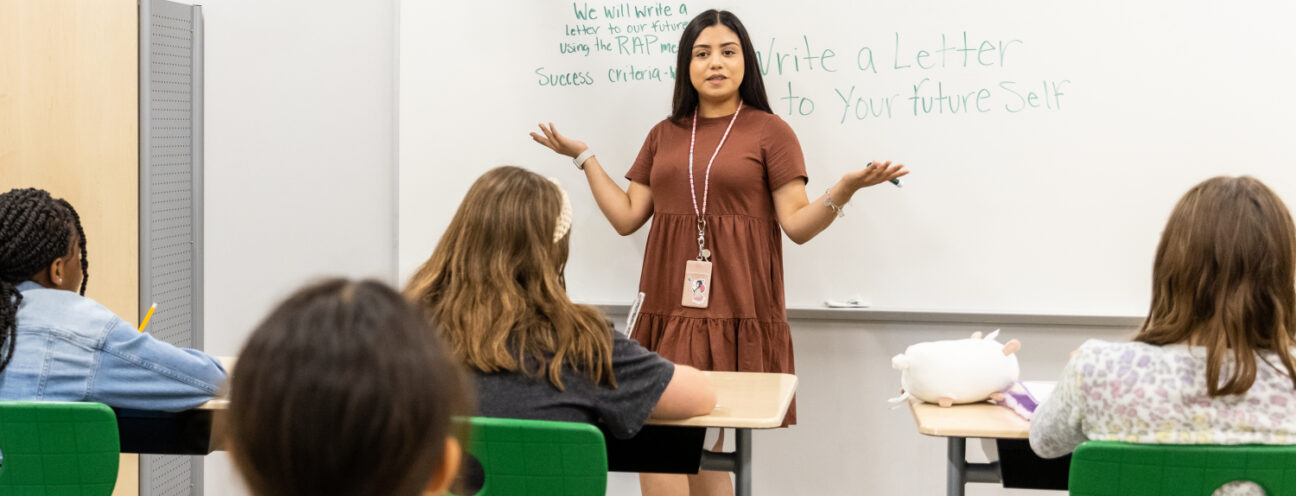Ask any experienced teacher and they will tell you that classroom management skills are key to a successful teaching career. While it may be tempting to think that managing a classroom is all about discipline and “running a tight ship,” the truth is far more complicated. A degree in teaching that starts students out with classroom observations is a good first step in learning this critical skill.
In this Article
What is Classroom Management?
Data shows that students learn better and teachers are more successful when the classroom is well-run. But what does that look like and how does it work, especially for students in different age groups and grades?
Classroom management is a framework for fostering a positive learning environment in a classroom setting by establishing clear expectations for behavior, conduct, and learning success. Teachers reinforce their classroom structure by using positive reinforcement and natural consequences for actions, among other classroom management skills.
Students aren’t born knowing how to behave in a classroom, especially in pre-K and kindergarten. As they grow older, their classroom needs change, so a fourth-grade teacher will have a different approach to classroom management than a ninth-grade history teacher.
Elements of classroom management skills include:
- Setting high expectations as a path to student success.
- Ensuring that positive reinforcement outweighs negative consequences.
- Consistency so students know what to expect.
- A framework that works for students based on their developmental and behavioral needs, not “one size fits all.”
Types of Classroom Management
Teachers lean toward different classroom styles depending on their personalities, cultural background, and training. They also make decisions based on student age and development, guidelines from the school they work in, the subjects they teach, and expectations for student success.
The following are four types of classroom management according to experts:
Authoritative. Teachers set clear rules and expectations, and encourage student input. This style of teaching can be adapted to all age groups, and fosters independent learning and student engagement.
Authoritarian. This approach prioritizes discipline and control, with strict rules. This style of teaching can feel restrictive and limits the connection between teachers and their students, but it may also provide a necessary structure that helps students focus.
Laissez faire. Students manage their own behavior and learning, with little input from the teacher. This can be difficult if students can’t regulate themselves, and may be better suited for older students who are self-motivated and eager to learn on their own.
Permissive. This classroom gives students autonomy with few rules, but it can also foster creativity and critical thinking skills. It can be uncomfortable for students who need more structure and it can be difficult for teachers to meet student success goals.
No matter the framework a teacher chooses, classroom management is not inflexible. As teachers go through the school year or gain more experience over the years, their approach to the classroom changes as well. If students don’t respond well to a permissive classroom, teachers can provide more structure. This ability to pivot is just one of many classroom management skills.
Top 9 Classroom Management Techniques
Novice teachers often start out with a strict classroom management style, but their approach changes as they gain more experience. Common classroom management structures include mostly the same techniques.
1. Set Up Your Classroom
Whether you want desks in a circle or traditional rows, a reading area in the back, or artwork and posters, the tone you set before the first day of school goes a long way toward establishing the classroom atmosphere. Classroom organization should reflect the goals of the class and the type of classroom style you want.
2. Communicate Classroom Expectations
On the first day, establish classroom rules, either top-down (i.e., authoritarian) or collaboratively with students. These could be behavior rules such as always raising your hand, turning in work on time, safety rules (such as for a science class), or other expectations. For younger students these expectations can include manners, such as being kind to classmates.
3. Build Relationships with Students and Parents
Get to know your students. Take time to meet with them where they are. Reach out to parents and make it easy for parents to reach out to you. At all ages, students will need support with social-emotional learning. Helping students learn to work past the frustration of gaining new skills is an important part of managing a class.
4. Establish Routines
For younger students, routine and structure are crucial. Meet students at the door and welcome them inside. Have set expectations of what they need to do next. For older students, expectations could include working on a problem on the board as soon as they get in, or handing in work, or putting their phones away.
5. Create Clear Lesson Plans
At all levels and ages, students thrive with clear lessons and goals. This doesn’t mean the work is simplified. It just means that teachers have thoughtfully put together the day’s lessons so instructions are clear. All students should feel free to ask questions if they don’t understand a particular instruction.
6. Use Tone of Voice and Non-verbal Cues
Teachers can convey a great deal of information with a simple tone of voice, a raised eyebrow, or a look (We all remember that teacher). The good news is that students will respond warmly to a warm tone, and tend to trust teachers who provide them with a supportive learning environment. Tone and non-verbal cues can help redirect disruptive behavior before it derails the classroom.
7. Focus on Positive Reinforcement
Experienced teachers talk about how they try to catch their students doing something good and praising them for it. Positive reinforcement can work for classroom behavior, for turning work in on time, and for both individuals and groups of students.
8. Have High Expectations
Students respond to high expectations. Teachers who set up students for success have clear lesson plans, give students actionable feedback and let them revise their work, and always let students know how they’re doing. Students who need additional time and instruction get additional support but lessons aren’t “dumbed down.”
9. Be Flexible
The classroom is a learning environment for teachers and students. If classroom strategies aren’t working for a class, teachers can pivot. If students aren’t engaging, it may be time to revise lesson plans, schedule a break, or ask students what they need. If behavior issues threaten to derail and disrupt, maybe a more rigid structure will help students focus.
How to Learn Classroom Management Skills
Classroom management is one of the biggest hurdles for many novice teachers. It’s so important that a recent study showed that new teachers were more likely to succeed as educators if they mastered classroom management skills quickly.
Learning good classroom management skills is not impossible, but it does require a lot of work and support from schools, administrators, and peer teachers. Here are some ways to learn to hone classroom management techniques.
Observation. During your student teaching experience, make sure that you get a chance to observe experienced teachers in all sorts of classrooms and see what works, how they redirect the class, and what doesn’t work.
Continuing Education. Professional development hours can help teachers learn new techniques based on data and child development science.
Mentorship. Find a mentor, whether that is someone in your teacher training, a teacher you student-teach with, administrator, or other guide who can help you identify issues and solutions.
Start Your Teaching Training at Austin Community College
Start your teaching career with an associate degree in education instruction from ACC. Student teachers combine classes with observation hours to get their associate degree and are prepared to transfer to the four-year program of their choice. Students also can get their bachelor’s degree and Texas teaching certificate through ACC and Texas Tech’s TechTeach program. Explore teaching programs and find your path toward a rewarding career as someone’s favorite teacher.
Back to Top

